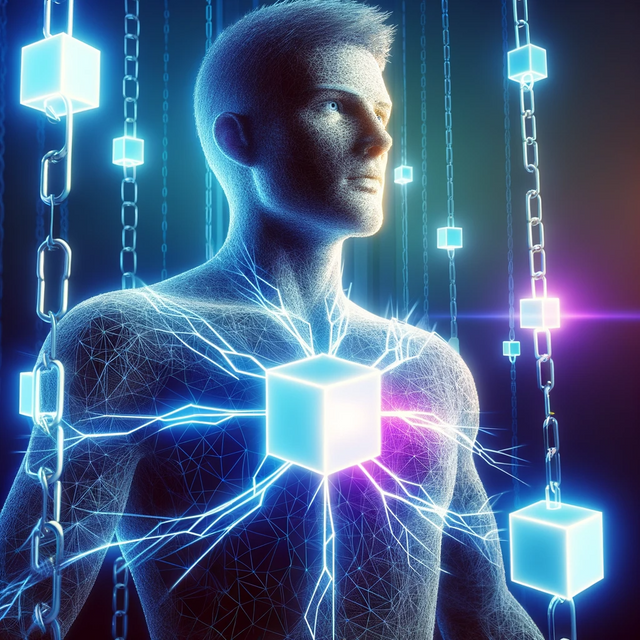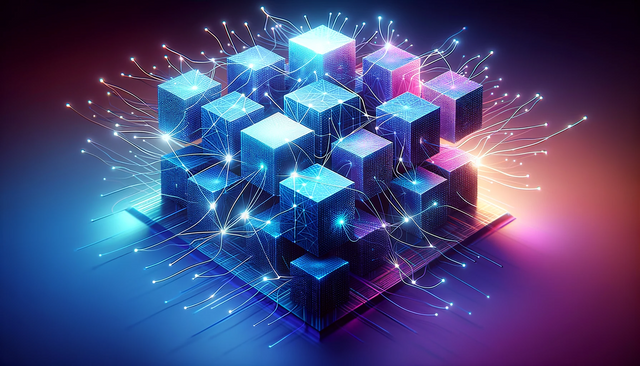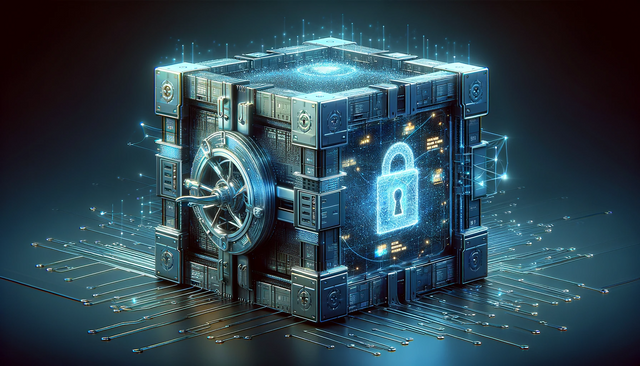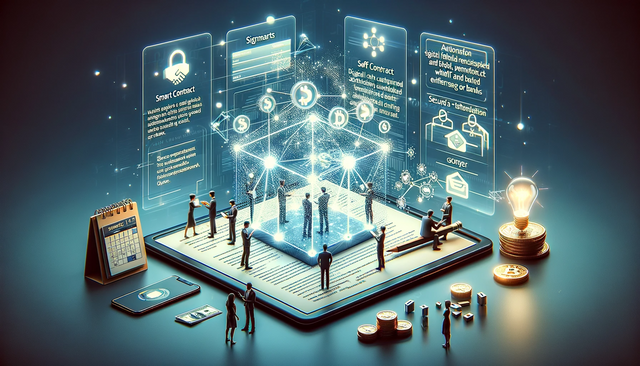BlockBasics 1.1.1: What is Blockchain? - A Beginner's Guide
Hello Steemians!
Embark with me on the BlockBasics journey, where we take our first steps into understanding blockchain. As a developer new to this field, I'm finding my way through the fog of buzzwords and technical jargon. I'm here to break down what I learn into digestible pieces, and I invite you to join this discovery process.
Blockchain appears as a beacon in the digital world, signaling a shift towards transparency and security. But what does this mean for us, practically speaking?
At this point, I must admit, the full implications are as clear as a dense fog. However, I understand that blockchain presents a new way of storing and sharing information that could redefine trust and collaboration in the digital age.
In its essence, blockchain is a chain of information, or 'blocks,' that are linked together in a way that is supposed to be tamper-proof.
The promises of blockchain hinge on transparency—every transaction is out in the open—and immutability—once something is written, it cannot be changed willy-nilly.
The importance of these principles is clear, but how they'll impact our daily lives is the journey I'm on, and I hope you'll walk this path with me.
👉 Transparency and Immutability: Not Just Buzzwords 👈
We hear terms like "transparency" and "immutability" thrown around, but what do they actually do for us? The concept of a world where digital actions are open for all to see and impossible to alter is intriguing. For now, I can't quite grasp the full scope of what this means for me, for you, or for the global community, but I'm determined to find out.
In this section, we'll dive into what blockchain is, its core principles, and why it's considered a cornerstone of modern digital trust. Whether you're here out of curiosity, for business, or a developer like myself looking to expand your tech horizons, this guide is your gateway to understanding the basics of blockchain technology.
Summary
- Understanding the Basics
- Definition of a Blockchain
- Centralization vs. Decentralization
- In everyday situations
- The Backbone of Blockchain
- The Core Principles of Blockchain
- Transparency
- Immutability
- Decentralization
- The Architecture of Blockchain
- Blocks as Digital Vaults
- Mining: The Craftsmanship Behind Blocks
- Chain of Blocks
- Blockchain as a Technology: Beyond Just Bitcoin
- Common Misconceptions About Blockchain
- Benefits of Blockchain
- Conclusion

1. Understanding the Basics
Definition of a Blockchain:
Think of blockchain as a communal diary that anyone can read, but no one can rip a page out of. Every "page" in this diary is a digital block where transactions are recorded in ink as permanent as a tattoo. For you, this means that every deal you make, whether selling an old guitar or buying an eBook, gets a page that's there for good, creating a history that's hard to dispute.
What this implies is that blockchain creates a record-keeping system that is extraordinarily resilient and transparent.
Prior to the advent of blockchain technology, our transactions and their records were mostly in the hands of third-party intermediaries like banks, lawyers, and other institutions. These transactions could be vulnerable to fraud, data breaches, and human errors. Here's how blockchain's features offer a significant improvement over the traditional systems:
- Enhanced Security Compared to Traditional Systems:
- Before: Security depended on the institution's protocols and was susceptible to internal fraud or data breaches. If you were banking online and the bank's system was hacked, your financial information could be compromised.
- With Blockchain: The security is inherent in the technology; tampering with records is computationally infeasible, making each transaction more secure than those relying on traditional systems. For example, if you were to transact using cryptocurrency, for instance, your transaction would be part of a block that is secured through cryptographic hashes, making it extremely difficult for hackers to alter without detection.
- Increased Trust Without Intermediaries:
- Before: Trust was established by having a reputable intermediary vouch for transactions, often with substantial fees involved. Buying a house traditionally involves several third parties (agents, lawyers, banks), which adds time and cost to the transaction.
- With Blockchain: Trust is established through a decentralized consensus mechanism, meaning no need for intermediaries, which can reduce costs and increase efficiency. Imagine a real estate transaction recorded on a blockchain. It could bypass expensive intermediaries, with smart contracts automatically executing when conditions are met, saving time and money for both buyer and seller.
- Proof of Ownership with Greater Accessibility:
- Before: Proving ownership could be bureaucratic, requiring paper trails and possibly leading to disputes if records were lost or damaged. Proving the authenticity of a luxury item like a Rolex watch usually requires paper certificates, which can be forged or lost.
- With Blockchain: Ownership is proven with a digital record that anyone can verify, simplifying the process and making it more accessible. With blockchain, the watch's authenticity and ownership history could be tracked on a digital ledger, making it easy for anyone to verify its provenance and for the owner to prove authenticity.
- Dispute Resolution with Immutable Records:
- Before: Resolving disputes could be a lengthy process with potential for lost or falsified records. In e-commerce, a customer and a seller might dispute over whether a product was delivered or returned.
- With Blockchain: The blockchain acts as a neutral record that can easily be referenced, simplifying and speeding up dispute resolution. With blockchain, delivery and return data can be recorded in an unalterable ledger, providing a clear and indisputable record of transactions, thereby simplifying and expediting the dispute resolution process.
- Permanent History Versus Alterable Records:
- Before: Records could be altered or lost, and maintaining them over time could be costly and complex. Medical records are typically held in hospital databases and can be difficult to transfer or access, sometimes leading to loss of information or errors.
- With Blockchain: Records are permanent, unalterable, and easy to maintain, reducing costs and complexity associated with long-term record keeping. Blockchain can be used to create a secure and unchangeable record of a patient's medical history, ensuring it is always accessible to authorized persons and reducing the risk of medical errors.
These examples demonstrate how blockchain offers a level of security, trust, and efficiency previously unattainable with traditional systems.
It's not just about technology but about reshaping how everyday transactions and interactions are conducted, making them more transparent, efficient, and secure for individuals and institutions alike.

Centralization vs. Decentralization:
Centralization is like having one librarian in charge of all book records in a town; if she makes a mistake, all records are wrong. Decentralization, which is the hallmark of blockchain, is like having each townsperson hold a copy of these records. If you lend a book to a friend, it’s like everyone makes a note of it. So, for you, this means more eyes are keeping your transactions safe and less chance of a single point of failure messing up your data.
- Centralized Example: Imagine you're playing a game of telephone where a message is passed through 10 people. If one person whispers the wrong phrase, the original message is lost or altered by the time it reaches the end.
- Blockchain's Decentralized Example: Now think of a scenario where you declare something in a group circle, and everyone hears it directly from you. They each write it down, cross-check it with each other, and agree on what was said. In blockchain terms, this is akin to a transaction being verified by a network of computers (nodes), and once they reach a consensus, it becomes a permanent record that everyone has access to and trusts.
In everyday situations:
- Selling a Used Car: Traditionally, this would involve paperwork and trust that neither party is trying to defraud the other. On a blockchain, the car's ownership history, including accidents, maintenance, and previous sales, could be stored on a digital ledger. The transfer of ownership could be recorded transparently and immutably when you sell the car. There's no need for a middleman, and the record is permanent and public for any future buyer to see.
- Writing a Contract: Normally, you might need lawyers to draft a contract, which can be costly and time-consuming. With blockchain's smart contracts, you can set conditions that self-execute when certain criteria are met, such as releasing funds when a job is completed, without the need for an intermediary. It's a bit like having a vending machine for legal agreements — put in the correct input, and the contract does the rest, visible and enforceable for all parties involved.
- Voting in Elections: In a standard election, you might worry about the integrity of the vote count. With blockchain, your vote could be cast as a transaction on a blockchain. It's anonymous but verifiable, ensuring it's counted and immune to tampering. This is like casting a vote that is instantly sealed in a tamper-proof box, the contents of which are visible to everyone but can only be changed with the consensus of the entire network.

The Backbone of Blockchain:
Blocks: Think of these as digital storage spaces, not too different from pages in a ledger. Each block contains a batch of transactions, like a diary entry, that details the ins and outs of what's been traded, who's involved, and when it occurred. But unlike a diary that can be erased or altered, once a block is filled and added to the blockchain, it’s like the entry is written with ink that can never fade or be scrubbed away.
Nodes: Every node is like a guardian of truth in the vast digital universe of blockchain. When your computer joins the network as a node, it's like swearing an oath to uphold the complete history of the blockchain ledger. Each node has a full copy of this ledger, and with every new transaction, they check their records against each other. This ensures that everyone agrees on what’s true and what’s not, much like a network of witnesses in a courtroom all verifying the same event.
Miners: These are the diligent workers who put the 'proof' in 'proof of work'. Miners use powerful computers to solve complex mathematical puzzles that validate transactions. It's as if they're competing in a high-stakes race to seal an envelope that contains a record of transactions. When they win the race, they get to add the envelope (a new block) to the chain of all the previous envelopes (the blockchain). For their effort, they are rewarded with cryptocurrency, like a gold miner finding a nugget as they dig. Their work is crucial because it's what keeps the blockchain secure and trustworthy.
2. The Core Principles of Blockchain
Transparency:
Blockchain technology allows for transparent transaction histories, making it easier for everyone to track and verify transactions.
Immutability:
Once data has been recorded inside a blockchain, it becomes very difficult to change it. This "immutability" makes it trustworthy.
Decentralization:
Decentralization reduces the risk of centralized control and potential manipulation. It's the principle that gives blockchain its power and appeal.
3. The Architecture of Blockchain

The blockchain is often depicted as a chain of digital "blocks," but let's expand on this visualization to truly understand its architecture.
Blocks as Digital Vaults:
Secure Storage: Each block is like a digital vault, safeguarding not only the details of transactions but also crucial metadata, timestamps, and unique identifiers. It's designed to be a fortress of information that, once sealed, becomes all but impregnable.
Data Fingerprinting: Inside each block is something called a hash — think of it as a fingerprint for data. Just as no two fingerprints are alike, each hash is unique to its block. Any attempt to change even a comma in the block's data would result in a completely different hash, signaling a breach in the chain.
Mining: The Craftsmanship Behind Blocks:
Cryptographic Puzzles: Miners are the master craftsmen of the blockchain world. They use powerful computers to solve extremely complex cryptographic puzzles. This process is not only a test of computational power but also serves as a security measure. It's akin to a combination lock on the digital vault — only the right solution opens it up to include new data.
The Race for Block Creation: Miners are in constant competition to solve these puzzles because the first to do so is rewarded with new cryptocurrency tokens. It's a digital gold rush, with each miner striving to strike it rich by adding the next block to the chain.
Chain of Blocks:
Unchangeable Record: Picture a blockchain like a row of dominoes. Each domino is a block. Once they stand in line, you can't change one without knocking down the rest. That's how the blockchain keeps each block safe from tampering — if you try to change one, it's really obvious because it affects the whole line.
Group Agreement: Imagine all your friends have a copy of a shopping list. To change the list, most of your friends must agree on the new items. Blockchain works similarly. It's like a group project where everyone has to nod 'yes' before any changes are made. This group checking makes sure no one can cheat.
Linking the Blocks: Each block in the blockchain is like a treasure chest in a sunken pirate ship, chained to the one before it. When you add another chest to the chain, it locks in place with the previous one. Together, they hold a treasure map that shows the history of all the trades and transactions, step by step.
4. Blockchain as a Technology: Beyond Just Bitcoin

While Bitcoin introduced blockchain to the world, blockchain's potential extends far beyond cryptocurrency. From smart contracts to supply chain management, blockchain is paving the way for a slew of transformative applications.
Let's explore some concrete examples:
Smart Contracts: Imagine signing a contract that automatically enforces itself. When you rent an apartment, a smart contract on the blockchain could automatically transfer the rent from your account to the landlord's on the first of the month, without any need for a bank or a check.
Supply Chain Tracking: Think of buying a coffee and being able to trace its journey from the farm to your cup. Blockchain can track each step a product takes, verifying its authenticity and ensuring fair trade practices. When you scan a barcode with your phone, you could see the entire history of the product, right back to its origins.
Voting Systems: Envision casting your vote in an election from your phone, secure in the knowledge that your vote is safe, anonymous, and counted accurately. Blockchain can create tamper-proof voting systems, potentially increasing transparency and trust in electoral processes.
Identity Verification: Instead of carrying various forms of ID, a blockchain could store your verified identity securely. You'd simply grant permission for entities to access it when necessary. This could make identity theft incredibly difficult.
Healthcare Record Keeping: Health records can be fragmented and hard to transfer. With blockchain, your health data could be securely stored and shared with authorized professionals in real-time, potentially saving lives in emergencies.
Real Estate Transactions: Imagine buying a house with the click of a button. Blockchain could store property records, automate the due diligence process, and facilitate instant transfers of property ownership, all while reducing fraud.
Intellectual Property & Royalties: For artists and creators, blockchain can protect intellectual property by creating indisputable records of content creation and streamline royalty payments so that artists get paid automatically when their work is used.
👉 And in the real life : 👈
Walmart's Food Traceability Initiative: Walmart uses blockchain technology to track the origin of food products. This system enhances the traceability of food items, helping to manage and isolate outbreaks of foodborne illnesses by quickly tracing products back to their source. Source : tech.walmart.com
Estonia's Digital Society Initiatives: Estonia has integrated blockchain technology into various public services. They use blockchain to secure health records, judicial, legislative, security, and commercial code systems, with e-Residency providing a digital identity to non-Estonians for business purposes. Source : www.pwc.com
De Beers' Diamond Traceability: De Beers employs blockchain technology to track diamonds from the mine to the retailer. This ensures that their diamonds are ethically sourced and not conflict diamonds, providing assurance to buyers about the origin and authenticity of their purchases. Source : ledgerinsights.com
5. Common Misconceptions About Blockchain
Understanding blockchain can be challenging, and misconceptions are common. Let's address some of these to further clarify what blockchain is and isn't.
Misconception: Blockchain and Bitcoin are the same.
👉 Clarification: Bitcoin is a cryptocurrency, whereas blockchain is the underlying technology that supports various cryptocurrencies, including Bitcoin. Blockchain's potential applications are vast and extend to numerous fields beyond digital currencies, such as healthcare, finance, supply chain management, and more.Misconception: Blockchains are completely anonymous and untraceable.
👉 Clarification: Transactions on many blockchains are pseudonymous but can often be traced. Public blockchains maintain a visible ledger of transactions which, while not directly listing personal identities, do show wallet addresses and can sometimes be linked back to individuals or entities through other data.Misconception: Blockchains are inherently secure and cannot be hacked.
👉 Clarification: While blockchain's structure makes it highly secure against tampering, it is not immune to all security threats. The technology relies on both the security of its software and the behavior of its participants. For instance, if more than 50% of the nodes in a blockchain are controlled by a malicious entity (a 51% attack), they could potentially disrupt the network.Misconception: All blockchains are public and open.
👉 Clarification: There are both public blockchains, like Bitcoin and Ethereum, and private or permissioned blockchains that restrict who can participate. Organizations might use private blockchains for internal processes where they need the benefits of blockchain without exposing data publicly.Misconception: Blockchain is a database.
👉 Clarification: A blockchain does store data, but it's different from traditional databases in its structure and purpose. Blockchains are better thought of as a distributed ledger or record-keeping system with high integrity and resilience against tampering.Misconception: Blockchain technology is only for the tech-savvy.
👉 Clarification: Although the technology behind blockchain is complex, its applications can be user-friendly. The end-users don't necessarily need to understand the technical underpinnings to use blockchain-based products or services. Just as you don't need to understand how the internet works to browse a webpage, blockchain applications are increasingly designed for ease of use.
6. Benefits of Blockchain
The benefits of blockchain include enhanced security, increased efficiency and speed, reduced costs, and improved traceability. These factors contribute to the technology's potential to instill trust in digital transactions.
Conclusion
We've scratched the surface of the vast, intricate world of blockchain technology. From its definition as a secure chain of digital blocks to its decentralized nature, we've explored how it stands to revolutionize not just finance with cryptocurrencies like Bitcoin, but numerous other industries.
As we stand on the brink of this exploration, remember:
Blockchain is a trust machine: It minimizes the need for traditional trust mechanisms, replacing them with transparent, immutable, and distributed ledger technology.
The potential is only starting to be tapped: Beyond cryptocurrencies, blockchain has applications in supply chain tracking, identity verification, intellectual property rights, and even voting systems.
It's a growing field: New advancements, applications, and implications of blockchain technology are being discovered and implemented all the time. What we see today may just be the tip of the iceberg.
Education is key: As with any emerging technology, the onus is on both developers and the public to educate themselves about the capabilities, risks, and benefits of blockchain.
Blockchain is not a panacea: While it has significant advantages, it is not the solution to all problems, and in some cases, traditional systems may be more efficient or appropriate.
Books:
Don't stop here! Keep exploring with these recommended books and resources to strengthen your understanding of blockchain. Your learning journey is just one block away from unfolding new opportunities.
- "Blockchain Basics: A Non-Technical Introduction in 25 Steps" by Daniel Drescher: Great for beginners who want a simple introduction without the tech jargon.
- "Mastering Bitcoin: Unlocking Digital Cryptocurrencies" by Andreas M. Antonopoulos: A deeper dive into Bitcoin and the technology behind it, which is great for understanding blockchain.
- "The Blockchain Revolution" by Don Tapscott and Alex Tapscott: A look at how blockchain technology can transform business, government, and society.
Previous articles:
😊 Join the Conversation:
What's your take on the blockchain revolution? 🚀 Have you encountered any applications of blockchain in your life or work that surprised you? Share your stories in the comments below! 👇
❤️ Support the Journey:
Every upvote 👍, comment 💬, and resteem 🔁 not only fuels my passion for writing but also supports the creation of more educational content. Let's demystify the tech together!